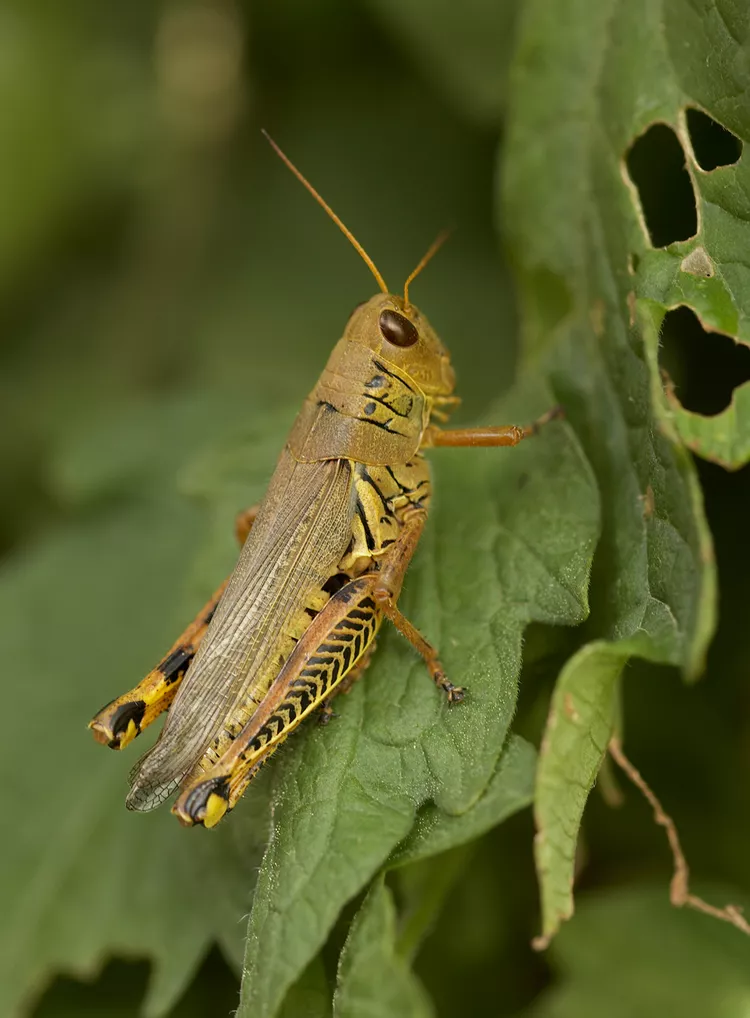Gardeners and grasshoppers are rarely on friendly terms, and understanding how to get rid of grasshoppers can save your plants. An outbreak (when swarms of insects hatch and begin feeding simultaneously) can devastate a small garden in just a few hours. Huge appetites, combined with the ability to jump or fly from plant to plant easily, make grasshoppers one of the most destructive garden pests. They're among the most challenging insects to control since they move so quickly, thanks to their big back legs and active wings. Not only do they readily move between plantings in one landscape, but they can cover great distances as they move from one neighborhood to another.
Learn how to combat a grasshopper outbreak with these tips.
How to Spot Grasshoppers in Your Garden
Grasshoppers are common throughout the United States. You might see them in shades of green, gold, or brown. They chew ragged-looking holes in plant leaves. In some areas, they begin feeding in early summer and continue devouring foliage until the first hard frost in fall, becoming more numerous as the season wears on. There are more than 100 types of grasshoppers, and they eat all kinds of plants. Some species eat weed plants and grasses with little garden value, while other species feast on vegetable crops, such as lettuce, carrots, beans, and corn, along with prized perennials.
Most grasshoppers emerge in the spring from eggs laid the previous fall. A cool, wet spring will destroy many of the hatchlings. A dry spring also presents challenges because there's often insufficient plant growth for the hatchlings to survive. Weather conditions at the time of the hatch have a significant impact on how many of the insects will invade your garden.
How to Get Rid of Grasshoppers
Grasshoppers invading your garden doesn't mean all your plants are goners. Here's how to get rid of grasshoppers and control their reproduction.
Attract Beneficial Insects and Other Garden Predators
Plant flowers, such as marigolds, calendula, sunflower, aster, alyssum, or dill to attract beneficial insects, like robber flies. A few other garden predators, such as spiders and toads, will also help keep grasshoppers under control.
Create a Bird-Friendly Garden
Many birds, such as kestrels and larks, eat large quantities of grasshoppers. To encourage birds to take up residence in your yard, provide a water source and nesting habitat. A diverse selection of native trees and shrubs will also attract birds.
How to Get Rid of Grasshoppers Naturally
A grasshopper disease called Nosema locustae slowly kills them, and it's a natural method of getting rid of grasshoppers. It's available as a dry, flaky product called Nolo Bait, which you can apply to areas where grasshoppers lay their eggs. It's important to reapply it after a rain. It's most effective on young grasshoppers, but not all grasshopper species are susceptible to the disease. Another option is a garlic-based repellent ($16, Arbico Organics).
How to Get Rid of Grasshoppers with Insecticides
If you choose to use insecticides, there are some essential points. First, insecticides aren't a completely controllable method of how to get rid of grasshoppers because they travel so much that the products you use may not kill them until after they damage your garden and move on to someone else's. Also, insecticides won't keep new grasshoppers from coming into your garden. And the products that kill grasshoppers also kill beneficial insects, so use them with extreme caution. Look for products containing carbaryl or permethrin. Apply insecticides when the eggs begin to hatch in May or June when they're young and less mobile.




















